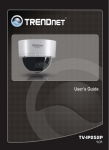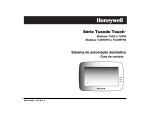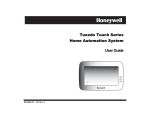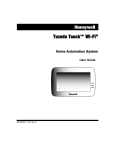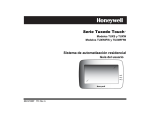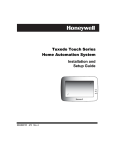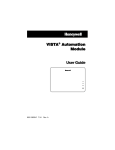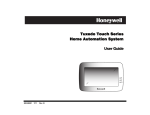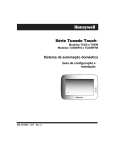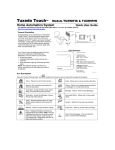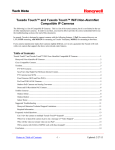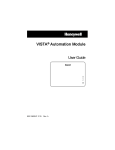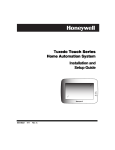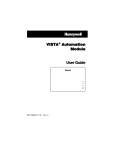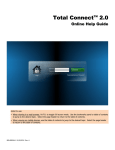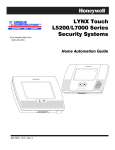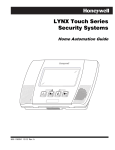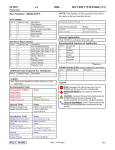Download Tuxedo Touch™ Wi-Fi
Transcript
Tuxedo Touch™ Wi-Fi® Home Automation System User Guide 800-16573V1 7/14 Rev. A Z-Wave devices are identified by the Z-Wave logo and can be purchased from your local retailer. ® Z-Wave is a registered trademark Sigma Designs, Inc. and/or its subsidiaries. Table of Contents ABOUT THE SYSTEM ......................................................................................................... 1 Introduction .................................................................................................................... 1 Tuxedo Features..................................................................................................... 1 Navigating through the Tuxedo ............................................................................... 3 SD Card for Multimedia and Software Updates ...................................................... 3 Data Entry Keyboard .............................................................................................. 3 Navigation Icon Descriptions .................................................................................. 4 LED Operation ........................................................................................................ 5 Messages ............................................................................................................... 6 Operating Modes .................................................................................................... 6 USING PICTURES, CAMERAS AND VIDEOS (MULTIMEDIA) .......................................... 9 Picture Setup .......................................................................................................... 9 Video Setup ............................................................................................................ 10 Viewing Cameras.................................................................................................... 11 Video Recording & Event Viewing .......................................................................... 14 Creating a Scene for Camera Recording ................................................................ 15 USING Z-WAVE DEVICES AND SCENES (AUTOMATION) ............................................... 17 ® Using Z-Wave Devices................................................................................................. 17 Manually Operating Devices ................................................................................... 17 Adding (Include/Add) Z-Wave Devices ................................................................... 17 Removing Z-Wave Devices .................................................................................... 19 Z-Wave Factory Default .......................................................................................... 20 Z-Wave Network Update ........................................................................................ 20 Z-Wave Device List................................................................................................. 21 Creating Scenes ..................................................................................................... 21 Room Setup ............................................................................................................ 23 Group Setup ........................................................................................................... 23 Setting a Secondary Tuxedo Controller .................................................................. 23 Updating Tuxedo with New or Removed devices ................................................... 24 Z-Wave Troubleshooting ........................................................................................ 24 USING THE SECURITY SYSTEM ........................................................................................ 25 Security System Operation ............................................................................................ 25 ii Table of Contents How to Arm the System .......................................................................................... 25 How to Bypass Zones ............................................................................................. 27 How to Disarm the System ..................................................................................... 27 User Codes .................................................................................................................... 29 Authority Levels ...................................................................................................... 29 How to Add a User.................................................................................................. 30 How to Delete a User.............................................................................................. 30 Fire and Carbon Monoxide Alarm Operation .......................................................... 31 In Case of Fire Alarm .............................................................................................. 31 Output Setup Function ............................................................................................ 32 More Choices................................................................................................................. 32 How to Clear/Hide a Control Panel Message ......................................................... 32 Advanced System Features .................................................................................... 32 Console Emulation Mode ........................................................................................ 32 How to Send Emergency Messages ....................................................................... 33 SETUP MENUS .................................................................................................................... 35 Brightness and Volume Control .............................................................................. 35 Display & Audio Setup ............................................................................................ 35 Language Selection (if applicable) .......................................................................... 35 Weather Forecast ................................................................................................... 36 Temperature Unit .................................................................................................... 36 Adjust the Screen Timeouts .................................................................................... 36 Clean Screen .......................................................................................................... 36 Routine Care .......................................................................................................... 37 Time/Date Setup ..................................................................................................... 37 Power Mode Setup ................................................................................................. 38 REMOTE ACCESS ............................................................................................................... 39 Network Connections.............................................................................................. 40 Remote Access Log In Setup (Account Setup)....................................................... 41 iii Table of Contents REMOTE SERVICES ........................................................................................................... 43 Using Total Connect with Tuxedo (Remote Services) ............................................ 43 Controlling Automation (Z-Wave) Devices Remotely .............................................. 43 Creating Scenes in Total Connect .......................................................................... 44 Viewing and Controlling Total Connect Scenes from Tuxedo ................................. 44 Enabling Devices for Total Connect........................................................................ 44 Total Connect Server Screen for Troubleshooting .................................................. 45 Software Updates ................................................................................................... 45 NOTES AND COMPATIBLE DEVICES................................................................................ 47 Supported Browser List .......................................................................................... 48 Warning Messages ................................................................................................. 48 Supported Camera List ........................................................................................... 49 Z-Wave Compatible Devices .................................................................................. 50 System Troubles ..................................................................................................... 51 NOTE: This device is a Security Enabled Z-Wave Controller iv About the System Introduction Congratulations on your ownership of a Honeywell Tuxedo Touch™ Home Automation System which combines home-automation and home security. Equipped with Wi-Fi® capability and built-in Z-Wave® technology, Tuxedo can be retrofitted into home electronic devices and systems without interference from common household wireless electronics. A Product/Training Video is provided containing easy step by step tutorials to assist with the setup and customization of your system. Tuxedo Features Feature Description Local Wi-Fi Access Remote Services (Total Connect) Tuxedo lets you control the system via any web enabled device such as a Smartphone, iPad® Android™ Tablet, Blackberry® or PC, using your home router. Home Automation Create Automation Scenes Tuxedo supports Remote Service for controlling Z-Wave devices and creating scenes for up to 20 Z-Wave devices remotely. Ask your installer if a Total Connect™ account has been set up. Refer to Remote Services section. Control lights, thermostats, door locks, shade openers and other Z-Wave devices automatically and easily add or remove Z-Wave devices to the system. Tuxedo supports 232 devices (including the Tuxedo keypads) in the Z-Wave network. Define system actions to automatically start when certain conditions occur. Supports up to 30 scenes. View Cameras View up to four cameras at the same time. Supports up to 32 cameras. Customizable Home Screen The Multimedia application allows you to display your personal photos(s) on the Home screen as wallpaper or in a slide show format via the external SD card. Tuxedo can record unlimited voice messages for others on the premises. The total time of all messages cannot exceed 120 seconds. Messages Video Viewing Tuxedo allows you view videos from the Home screen. A Video Converter is required. See Video Setup section for details. Security System Control your security system via Tuxedo menus. Offers you burglary protection and may provide fire, carbon monoxide and emergency protection. See your installer for details. Tuxedo can activate/deactivate up to 18 pre-defined control panel output functions (if programmed in the control panel). These output functions are typically used to turn on lights or active relay devices. Output Setup Function Weather Forecast Operating Modes The *Weather forecast (if enabled) is displayed on the “Home” screen. Press the “Weather” feature to enter your location and temperature unit. *Enable the weather option at: Setup > System setup > CS Setup > Options. Normal Mode - used for normal operation. Demo Mode - allows the automation and multimedia features to operate in a 1 About the System (cont'd) Feature Description non-security mode for demonstration purposes only. Automation (Occupancy) Mode is used to simulate a security system when a security system is not connected. Automation mode allows you to set the Tuxedo in two conditions: Residential and Commercial. Scenes can be set to trigger based on the status of these settings. Safe Mode is a limited mode of operation that serves as a backup mode to ensure that you can communicate with your system. Refer to the Safe Mode section for further information. Switchable Switch from normal view to mobile view depending on the type of device used with Themes (Views) the Tuxedo. Refer to Remote Access section for details. Each user was assigned a name and 4-digit user code by your installer at the time User Codes of installation. Additional users can be added as needed. Additional control panel functions can be accessed through the console emulation Extended Functionality mode which emulates a standard alpha keypad on your Tuxedo touch-screen. Refer to your Control Panel User Guide for these features. If needed, various system settings can be programmed including time and date, Setup Menus remote access, display and audio features, language selection, etc. UL Wi-Fi has not been evaluated by UL. 2 About the System (cont'd) Navigating through the Tuxedo Navigation through the Tuxedo typically begins from the "Home" screen. It is from this screen that you select from the main menu. Once you have made your selection, you can navigate through various submenus by pressing graphical icons to perform the function you desire. READY TROUBLE Monday Security Automation The background and icons shown on the “Home” screen in this manual are for example only. Your system installer may have changed the actual background and icons shown on your “Home” screen. City 01/06/2014 Temp N/A 07:45AM Humidity N/A Wind Con N/A MultiMedia IP:10.10.10.100 SD Card for Multimedia and Software Updates The Picture/Video features allow you to display personal photos, and view video files via the external SD card. In addition, software updates can be downloaded to the SD card, if necessary. An SD card is provided with 4GB of available space. It is recommended that you use the SD card supplied. In everyday handling, memory cards can become susceptible to malfunction and/or failure due to electrostatic discharges and the information on the card may be lost. In some extreme cases, the Tuxedo may need to be reset. NOTE: Honeywell is not responsible for any loss of personal information (files, videos, photos, etc.) Memory Card Insertion Insert the memory card (SD/SDHC Card) as shown. Tips for proper memory card handling: • Avoid touching the contacts on the card • Quit the slide show/video application before removing the memory card. INSERT CARD 6280-004-V0 Data Entry Keyboard Throughout this document, the user is required to enter information on the Tuxedo keypad (i.e., password, device names etc.) Use the Data Entry Keyboard to enter all required information. • • • • • Press the “up arrow” to switch to upper case characters. Press the Space key to add a space between characters. Press the x key to delete/backspace. Press the ABC/123 key to switch between numerals and symbols/characters. Press GO to return to the previous screen. 3 About the System (cont'd) Navigation Icon Descriptions To aid in the navigation through the Tuxedo screens, a set of user-friendly icons has been provided. The appearance and function of these icons are described below. ICON ICON TITLE FUNCTION “Product Video” Accesses Product Introduction and Training Videos. “Setup” "Automation” Accesses the Z-Wave setup, Scene setup, and Room/Group setup screens. “Multimedia” "Security” “Home” “Panic” “Back” “Annunciate Status” ICON Accesses the "Security" screen. ICON TITLE “Video” Returns to the Main menu (Home) screen. Displays Emergency functions (as programmed by the installer). Note: This icon is displayed and active on all screens except while in the Clean Screen mode, during an LCD Display test in Diagnostics and from the Video and Camera screens. FUNCTION Accesses the Setup menus. Accesses the Message, Camera, Picture and Video features. Allows user to play video files. “Picture” Allows user to display personal photo(s) as wallpaper or in a slide show format. "Message” Record and retrieve Voice Messages. “Camera” Press to access camera settings. “Event View” Press to access video recordings. Returns to the previous screen. “Control Panel Message” This icon alerts the user to a Control Panel Message. Allows user to hear system status. “Weather” Press to access weather settings. 4 About the System (cont'd) LED Operation The Tuxedo has three LEDs as follows: SD/SDHC CARD Slot ARMED (RED) LED ON – System is armed. OFF – System is not armed. READY (GREEN) LED ON – System is disarmed and ready to arm. OFF – System is armed or disarmed but not ready. If disarmed, faults or troubles are present. MESSAGE (YELLOW) LED FLASHING – The system contains new message(s) for the User. OFF – No new messages. RESET BUTTON Press to reset keypad 6280-001-V0 If using Occupancy mode the LEDs are as follows: LEDs FUNCTION COLOR STATUS Automation (Occupancy) Mode RED ON Residential mode = system is set to AWAY or NIGHT. Commercial mode = system is set to CLOSE or NIGHT. GREEN ON Residential mode = system is set to HOME. Commercial mode = system is set to OPEN. Screen Blackout (EN50131 Display) The Screen Blackout feature prevents unauthorized users from viewing the status of the Security System by returning to the Home screen and turning off the Armed and Ready status LEDs. When the EN50131 Display is turned ON: • The keypad returns to the "Home" screen after 30 seconds; "Armed" and "Ready" LEDs turn OFF. • The "To Homepage After" time setting changes to 30 seconds and the time is non-selectable. • The “Auto Slideshow After” is preset to “1” minute and cannot be changed. • The Security, Message and Lighting screen does not display system status until an authorized user code is entered. • The "Setup" menu does not display system status until an authorized user code is entered. • Videos cannot be played. 5 About the System (cont'd) Messages The Tuxedo can record voice messages for others on the premises. The number of messages is not limited; however, the total time of all messages added together cannot exceed 120 seconds. Note: The voice messages are stored in the memory and all messages are lost if the keypad loses power or if it is reset. Recording/Retrieving Messages Press the Multimedia screen is displayed. and Message icons. Enter your Authorized code; the “Message Center” icon and record your message while staying within approximately one foot of Press the RECORD the keypad and speaking at a normal voice volume. As you are recording your message, the remaining time counter counts down to indicate the total remaining time available and a “Recording New Memo…” message is displayed above the message list window. Press the STOP icon when you are done recording the message. To listen to a voice message, highlight the message and then press the PLAY icon. As the message is being played, a “Play (#): Voice Memo…” message is displayed above the message list window. The Message LED continues to flash until all new messages have been played back entirely. When the end of the message is reached, the playback stops. To listen to the next message or previous message, press the NEXT and PREV icon. To delete the selected message, press the DELETE Del Selected icon. A confirmation window is displayed stating: Selected Memo 2: 11/02/12 00:30:00 Select Yes or No. To delete all messages, press the DELETE ALL icon. A confirmation window is displayed stating: “Confirmation” Do you want to delete all messages? Select Yes or No. To exit, press the Back and Home icon. Notes: 1. Each message is numbered, dated and the length of the message in seconds (Sec) is displayed on the message list. 2. Use the slide bar to raise and lower the message volume. Operating Modes Automation (Occupancy) Mode This mode is primarily used with the Scenes features to automate certain scene actions and does not communicate with the control panel. Note: The Automation/Demo Mode option allows the automation and multimedia features to operate in a non-security mode. When this option is selected, the keypad does not communicate with the control panel and any user can select Advanced Setup screens. Automation mode allows you to set Tuxedo in two conditions: Residential and Commercial. Scenes can be set to trigger based on the status of these settings. In Residential mode (default), the Arming options are: Home, Away, and Night. 6 About the System (cont'd) In Commercial mode, the Arming options are: Open, Close, and Night. To enter Residential mode (automation), from the “Home” screen press the following icons: Setup > System setup > CS Setup . Enter your authorized code and press the Options icon; the “OPTIONS and OPERATING MODES” screen is displayed. Highlight the Automation Mode check box to enable the option. To change the occupancy delay time, (the amount of time you want to allow for authorized entry or exit without causing an alarm) select a time interval from the Occupancy Delay drop-down list: choose from 15, 30, 60, 120 or 225 seconds. When done, press Apply to save the settings. The message is displayed: “WARNING Keypad will reset to activate changes … Do you want to save changes.” Select Yes or No . To enter Commercial mode (automation), from the “Home” screen press the following icons: Setup > System setup > CS Setup . Enter your authorized code and press the Options icon; the “OPTIONS and OPERATING MODES” screen is displayed. Highlight the Automation Mode check box to enable the option then select the Commercial check box. To change the occupancy delay time, select a time interval from the Occupancy Delay drop-down list: choose from 15, 30, 60, 120 or 225 seconds. When done, press Apply to save the settings. The message is displayed: “WARNING Keypad will reset to activate changes … Do you want to save changes.” Select Yes or No . Normal Mode Normal Mode is used when a control panel is connected and provides security functions. Demo Mode Demo Mode allows the automation and multimedia features to operate in a security mode for demonstration purposes only. Safe Mode The Safe Mode may be automatically entered by the program on a communication failure or may be entered manually on command. To Exit the Safe Mode: ! SAFE MODE ! 1. Press the ! SAFE MODE ! bar . 2. Select “Yes” to return to the Normal Mode of operation. Tuxedo resets and normal operation returns as long as the original conditions that caused the entry into Safe Mode do not still exist. To Enter Safe Mode: 7 About the System (cont'd) 1. Select Safe Mode and then press Apply. 2. Press the OK icon. 3. To exit, press the safe mode bar and press Yes to return to Normal Mode. • While in the Safe Mode, the Home screen displays the Security, Panic, and Message Icon. A message !SAFE MODE! Is displayed at the lower left side of the screen. • Tuxedo resets and restarts in the Safe Mode. In the rare event that Tuxedo cannot successfully communicate in its graphic mode with the control panel, the Safe Mode is a backup mode that ensures that you can communicate with your system. In this mode, the keypad operates much like a standard non-graphic keypad so that you can control your system until the problem is corrected. If this situation occurs, Tuxedo presents you with a message of “Problems detected. Start Keypad in Safe Mode?” and requests a “Yes” or “No” response. If you answer with “Yes,” Tuxedo enters into the Safe Mode. If you answer with “No,” Tuxedo tries to communicate with the panel again. After 3 consecutive times of receiving no response, Tuxedo enters the Safe Mode automatically. Note: Use care when providing the “Yes” or “No” response. Pressing the screen outside the prescribed area may cause the background to come to the front. If this occurs, the Yes/No message that disappeared times-out in 30 seconds even though it is not visible. Then Tuxedo resets into the Normal Mode (or Safe Mode if this is the third time that the warning message appeared). Note that this is a limited mode of operation. While in this mode: • You can use the Security icon to access the Console Emulation Mode of operation to try to clear your faults, disarm the system, or enter additional Alpha Keypad commands specified in your panel User Guide. You can perform almost all functions that you can perform from a standard non-graphic alpha keypad. • You can press the “Panic” key and generate Emergency Messages as defined in the panel’s home partition for this keypad. • The Armed and Ready LEDs on the front of the keypad indicates Tuxedo’s home partition status. The Message LED (on models with Voice feature) or Trouble LED (on models without Voice feature) is not active in the Safe Mode. • The Chime mode functions in the Safe Mode, however, you do not have Voice (system status messages), Voice Chime (announcements) or Message capability (if set to default “Master”). • Z-Wave Scenes do not function in Safe Mode. • When an alarm occurs in the Safe Mode, it is displayed on the Console mode screen only and is not shown on the Home screen. • The Slide Show feature does not start automatically in Safe Mode. 8 Using Pictures, Cameras and Videos (Multimedia) Picture Setup Tuxedo can display your personal photo(s) on the Home screen as wallpaper or in a slide show format. To set up a slide show of pictures, do the following: Insert your personal media SD card (with stored picture files). Formats supported are .bmp, png or .jpg files. and Picture Press the Multimedia images appears on the screen. icons. The first image is displayed and a list of stored To add an image to the slide show, select the image from the list and press the Add Image icon; the image appears on the screen and a check mark appears next to the selected image name. Press the Slide Delay arrow to select the time interval that you want to allow between each photo being viewed. Choose from (5, 10, 15, or 20 seconds). Press the Transition arrow to select the type of viewing transition desired (Standard, Horizontal, Vertical or Fade Out). After images have been added, press the Play Image icon to begin the slide show. To remove an image from the slide show, select the image, and press the Deselect Image To move to the Next Image press ; to go back to a Previous Image press icon. . To set a picture as wallpaper: 1. Use the slide bar to highlight the file you want to be displayed on the screen. 2. Press the Set Wallpaper icon; view your selection from the “Home” screen. Press the TOP button to move up one level in the directory. Press the OPEN button to view larger images and/or open directories from the list of images. Press the CLEAR ALL button to clear all pictures from the current slide show rotation. Notes: • To exit slide show at any time and resume keypad operation, press anywhere on the screen. • When an image is loading, no other Picture Setup function can be performed (play, previous, next, add or set wallpaper). UL Multimedia functionality is supplementary only and has not been evaluated by UL. 9 Using Pictures, Cameras and Videos (Multimedia) (cont’d) Video Setup Video Converter is required to convert videos for proper playback on the Tuxedo. Use an Internet search engine to locate and download a Video Converter, then follow the steps in the Video Converter Instructions (provided in the carton). icon (located on the Home screen) and view the “SD Card Video Press the Product/Training Video Playback” training video to learn more about this feature. To play a video: Insert your personal media (SD/SDHC) card (with stored video files). Formats supported are MPEG4 and H.264, containers AVI, MOV, MP4. From the “Home” screen, press the Multimedia and Video icons. Press the Video button. Use the slide bar to scroll through the video list. Highlight a video file from the list and press Play to start the selected video file. Press the Repeat icon to continually replay the selected video. Deselect the Repeat icon to automatically play the complete list of video files starting with the first video and ending with the last. Press the appropriate icons to Pause or view a Full View . Notes: • Maximum video resolution should not exceed 640 x 480. • If the video file causes Tuxedo to lock, use a small object (such as a paper clip) to press the reset button located in the lower right-hand side of the keypad to reset it. • To exit Full View mode at any time while a video is playing, press anywhere on the screen. • When in Full View mode there is an 8-10 second delay for video display. 10 Using Pictures, Cameras and Videos (Multimedia) (cont'd) Viewing Cameras Cameras can be viewed locally from the Tuxedo keypad. To setup and view cameras for use with WiFi enabled devices and Total Connect, refer to the Remote Access section later in this document. UL Camera functionality is supplementary only and has not been evaluated by UL. Your installer may have installed one or more cameras at the time of installation. If you want to add cameras to the system, see the Adding Cameras to the System section. Camera Icons CAMERA SETUP PLAY PAUSE AUTO PAN QUAD VIEW FULL VIEW PAN/TILT CONNECT RESET BACK IMPORTANT: Use the web browser to view cameras for non-security purposes only. Camera streams viewed from the web browser can stop without indication due to network connection issues. To view cameras locally, do the following: 1. Press the Multimedia and Camera icons. a) Highlight the View Cameras button; images from installed cameras appear. Use the Quad View button to view up to four cameras on the same screen. Select a quadrant area on the screen and then select the camera that you want to appear in that quadrant. For pan/tilt style cameras, use the Pan/Tilt icon to change the angle of the selected camera. b) Highlight the New Camera button and enter the IP address of a new camera for viewing. Note: This feature requires installation of QuickTime® on the smart device. Devices for Android do not currently support QuickTime. Notes: • QuickTime® media player must be installed on your PC. • Camera viewing is compatible with IE8 (and above) and Safari 5.0 (and above); and not compatible with Opera web browsers. • Some older versions of these cameras may need a firmware upgrade; see separate instructions. 11 Using Pictures, Cameras and Videos (Multimedia) (cont’d) Adding Cameras to the System Note: Tuxedo must be Wi-Fi connected to the home router before adding cameras. Initial camera setup cannot be performed over a wireless connection. The Camera feature allows you to enroll cameras and view up to four cameras at one time using the quadrant view feature. View the “IP Camera Setup” training video for helpful information to aid in the setup and follow the steps below to add cameras. 1. Before mounting your camera, connect a Cat5/6 cable to the back of the camera and connect the opposite end to the Ethernet port on your router. Apply power to the camera. Wait a few seconds for initial power-up of camera. 2. Press the Multimedia , Camera Management screen is displayed. and Camera Setup icons. The Camera Setup 3. Press the Discover icon to locate the camera. The screen displays: “Discovering cameras … Please Wait…” Once located, highlight the camera address and go to Step 6 below. Repeat this step until all cameras are discovered. If the camera information is not automatically obtained, press the Add “Add New Camera” screen. icon to manually enter the appropriate wireless information on the 4. To edit information, highlight the camera name and press the Edit icon. Highlight each field and enter the required information if known, (see Add/Edit Options below), and then press Save . To retrieve camera settings and connect to the camera, press the Connect icon. Add / Edit Options Name: Enter a camera name; Address: Enter IP or URL; RTSP Port #: Select from (554, (102465534)). MJPEG: Fixed; Mobile: Fixed. Model: Select iPCAM-WI, iPCAM-WI2, iPCAM-WI2B (black), iPCAM-WO or iPCAM-PT, WVC210, iPCAM-ACU, iPCAM-WL, ONVIF, Trendnet, AXIS-M1011-W, OTHER. User Name: Fixed; Password: Fixed. Resolution: Select from 160 x 120, 320 x 240 or 640 x 480. For best performance set video resolution to 320 x 240, 8 frames per sec. Note: Model iPCAM-WL resolution is fixed at 320 x 240. Frame Rate: Select from 1, 2, 3, 4, 5, 6, 8, 10, 15, 20, 25, or 30. Note: When setting the resolution to 640 x 480, the recommended frame rate is 8 frames per sec. When setting the resolution to 320 x 240, the recommended frame rate is no more than 15 frames per sec. *HTTP Port Number: Default value = 80; to change, enter valid port number (80 (1024-65534)). Do not use ports 6665-6669 for camera HTTP configuration. These ports block MPEG streaming and PT commands of Safari based PC and mobile devices. 12 Using Pictures, Cameras and Videos (Multimedia) (cont'd) 5. If using Total Connect, press the Total Connect icon to reset the camera for remote viewing and activate a Total Connect account. A pop-up window displays: “For remote camera viewing service, please contact your alarm company and ask for Total ConnectTM service and provide the camera’s MAC ID XX:XX:XX:XX:XX:XX. Press continue to prepare the camera for Total Connect service.” Press CONTINUE or CANCEL. If you press Continue a confirmation window displays: Do you want to reset the Camera? Yes or No. See Remote Services section, later in this document. Press Save when done. Use the Refresh screen, if necessary. icon to update the icon to enter the 6. If using WiFi, after all cameras have been added, press the Camera WIFI camera wireless settings information from your router. The screen displays: “INFO: Camera WiFi setup is applicable only for discovered cameras” a) Enter the appropriate wireless information. SSID: ANY. Security Mode: Disabled, WPA personal, WPA2 personal, or WEP. Network Type: Infrastructure. Domain: USA. Channel: Auto. b) Security Mode information enter: Tx Key: 1, 2, 3 or 4; WEP Encryption: 64 bit Key (10 Hex Chars) or 128 bit Key (26 Hex Chars). Authentication: Open System or Shared Key; Passphrase: then press GENERATE. Key: must consist of 10 hexadecimal characters. c) Press Apply to All to set cameras for wireless operation. Press Save when done. A pop-up window displays: “Info XXX.XXX.X.X WIFI Configuration Saved” d) Press the Settings icon to enter Video, Network, Wireless, and Other settings; refer to “Advanced Camera Settings” below. Note: Cameras must be enrolled to access the Settings screen. If multiple cameras are enrolled, highlight the desired camera to make changes. 7. Remove the Ethernet cable from the wireless cameras to view wirelessly via the Tuxedo keypad. If the camera does not have wireless capability, leave the camera connected to router. Advanced Camera Settings Press Save! after each selection. Video Settings: Select the following: MPEG-4 Settings: Resolution, Fixed Quality and Max. Frame Rate MJPEG Settings: Resolution, Fixed Video Quality and Max. Frame Rate Network Settings: To make changes to the selected camera: Internet Connection type: If set to Obtain an address automatically, selectable options are Enable Discovery for UPNP, HTTP Port, RTSP Port. If set to Static IP, options are IP Address, Subnet Mask, Default Gateway, Enable Discovery for UPNP, HTTP Port, RTSP Port. Wireless: View the following settings: SSID, Security System, Passphrase/Shared Key, Network Type, Domain and Channel Information. Others: Reset to Defaults: a pop-up window displays: “Do you want to reset the Camera?” 13 Using Pictures, Cameras and Videos (Multimedia) (cont’d) Select Yes to reset the camera to factory default settings. Restart Camera: Press to restart the camera. Removing Cameras 1. To delete a camera, highlight the camera name and press the DELETE icon. A confirmation window displays: Select “Yes” to permanently remove the selected device from the list. Note: Select “Delete All” then select “Discover” to rediscover all devices. Yes or No. 2. To delete all cameras, press the DELETE ALL to delete all cameras? Yes or No. icon. A confirmation window displays: Do you want Video Recording & Event Viewing Recording Setup The camera Recording feature allows you to create a scene for recording two minutes of video events onto the SD card. The first 15 seconds record the pre-event and the remaining time records the postevent. Up to four simultaneous video events can be recorded and the first four supported cameras will be associated (automatically) to the recording. An SD card is required to store the recordings but if the “Critical Events” option is enabled, a maximum of two events is recorded even when the SD card is not available. If more than two critical events occur, then the older one is replaced by the latest event. When the SD card reaches full capacity, the SD Card Full icon is displayed. To access the recording feature: Press the Camera , Camera Setup , Camera Settings icons. To change the settings for resolution, fixed quality and frame rate, select from the drop-down list. Note: When setting the resolution to 640 x 480, the recommended frame rate is 8 frames per sec. When setting the resolution to 320 x 240, the recommended frame rate is no more than 15 frames per sec. Press Save when done. This will return you to the “Camera List” screen. Press the Recording Settings Setup drop-down list. Press Save icon and select the camera to use for recording from the when done. 14 Using Pictures, Cameras and Videos (Multimedia) (cont'd) Creating a Scene for Camera Recording To create a scene for camera recording, press the Automation , Scene Setup and Add Scene icons. In the Trigger section, press the Edit done. icon to define the event Trigger type; press Save In the Action section, press the Add icon to define the event Action type. Select the Recording button. Select the camera(s) for recording; press Save when when done. Refer to the “Creating Scenes” section for details. Notes: • In some cases, you may see the video playback for the duration of less than the full two minutes. If this occurs, it is recommended that you lower the frame rate and resolution to 320 x 240 @ 5 FPS. • Recorded video events are always in 24 hour format regardless of keypad time format. • Removing the SD card during video recording and playback may cause SD card corruption and loss of data. To ensure recording is not in progress, before removing the SD card, check the video recording status by exiting the Video Event screen and checking the recording status icon on the lower left side of the Home screen. Manual Video Recording The camera recording feature can be used manually to record events to an SD card (supplied). To access the manual video recording feature, press the Camera Record Select the desired camera for recording and then press the Record Press the Record minutes. icon. icon to begin recording. icon again to stop the recording. Note the maximum recording duration is two Event Viewing To view a cameras’ recorded event: Press the Multimedia and Event View icons; a list of events appear on the screen. Press the Event View Setup icon and select the “Filter by Camera” button to view a specific cameras’ event, select the “Show All" button to view all camera events or select “Filter by Critical” to view (if enabled) a maximum of two events that have been stored when the SD card is not available. Press Save when done. Highlight the event from the list to view, and press Play Use the Delete icon to remove the event video. 15 . Using Pictures, Cameras and Videos (Multimedia) (cont’d) 16 Using Z-Wave Devices and Scenes (Automation) Using Z-Wave® Devices Before a Z-Wave device will work in the home control network, it must be added (also called “included”) into the network. View the “Programming of Z-Wave Devices” training video and follow the instructions below to Include Z-Wave enabled devices into a home control network. Your installer may have added Z-Wave devices into your home control network at the time of installation. To add more devices see Adding Z-Wave devices below. Manually Operating Devices Devices can be programmed to operate automatically based on scenes you define (refer to Creating Scenes section). Alternatively, you can manually control a device using the Z-Wave Management screen. Press the Automation and Z-Wave Setup icons. Adding (Include/Add) Z-Wave Devices Each device must be installed according to the manufacturer’s instructions. Before starting, make sure light modules are on, door locks are assembled and have their batteries installed, and thermostats are installed and operating. WARNING: Automation is intended for lifestyle convenience. Do not use automation for life safety and property protection. 1. Press the Automation and Z-Wave Setup icons to display the “Z-Wave Device Management” screen and then press the Z-Wave Add icon. 2. At the Z-Wave device, press the appropriate Function button depending on the type of device being added. Refer to Device sections that follow. Light, Switch or Outlet Module Be sure the power switch on the device module is ON. Press the Function Key on the device. Note: Z-Wave light modules may vary; follow the instructions in the User Guide for your specific device to include properly into the Z-Wave network. • If a dimmer module (multi-level switch) was added, an On/Off button and a slide bar (to control the dimmer) are displayed. • If an on/off light/ appliance module (binary switch) switch, an On/Off button (to control the device) is displayed. The screen displays a series of messages: “Start add device” “Please press function key on device” “Adding Controller Unit” “Adding Slave Unit” “Device added successfully” UL • Automation functionality is supplementary only and has not been evaluated by UL. • Z-Wave applications have not been evaluated by UL. 17 Using Z-Wave Devices and Scenes (cont'd) Door Locks (Entry Control) Assemble the Z-Wave door lock. IMPORTANT: Be sure the door lock orientation/handedness is correct before adding into the system. Door lock devices may vary; follow the instructions in the User Guide for your specific door lock to include properly and to program a new user code. Refer to the Door Lock’s Instruction Guide and connect necessary cables, then install batteries. Enroll the door lock within 5 feet of the keypad. Notes: • Program the user code in the control panel prior to programming that user code into the door lock. User Codes must be 4-digits. • If software is upgraded on the Tuxedo Touch keypad, enroll the door lock again and re-set the user code in the door lock. Include a door lock device into Tuxedo as follows: 1. Press the Function Key on the door lock 2. Program the selected user code assigned in the panel; refer to Door Lock User Guide. The screen displays a series of messages: “Please press * function key on device” “Adding to Security Network” “Device added successfully” UL Access control functionality has not been evaluated by UL and may not be used in UL Listed applications. Honeywell Thermostat Install Honeywell Thermostat according to the manufacturer’s instructions. The device should be mounted in the final location and tested before adding it to the system. Notes: • Honeywell is not responsible for property damages due to improper setting of the thermostat modes. • If installing another brand of thermostat, follow the instructions in the User Guide for that specific thermostat to include properly into the Z-Wave network. • If not using a Honeywell thermostat, enrollment procedure may vary. Refer to the thermostat instructions for enrollment procedure. • Some thermostats do not update temperature status automatically (i.e., Wayne Dalton). 1. At the Z-Wave thermostat: a) Select Thermostat; set the Time and Date. b) Follow the instructions in the thermostat Installation Guide for “Z-Wave enrollment.” c) To complete inclusion, press Done. d) Press Exit to return to normal operation. 18 Using Z-Wave Devices and Scenes (cont'd) 2. At the Tuxedo: a) To verify activation, press the Back icon and wait 30 seconds. Press the Refresh new device is displayed. The keypad displays a series of messages: icon; the “Please press *function key on device” “Adding Controller Unit” “Adding Slave Unit” “Device added successfully” Editing Z-Wave Device Names To edit a device name, do the following: 1. Press the Automation Management” screen. and Z-Wave Setup icons to display the “Z-Wave Device 2. Highlight the device name and press the Edit Name 3. On the “Data Entry” keyboard, press the GO. icon. in the device name field and enter a new name; press Removing Z-Wave Devices Notes: • The Remove Device icon clears the node from the keypad and resets device to the default setting. • To remove a defective device, or if the device is not removed, refer to the “Z-Wave Troubleshooting” section. • When removing the door lock, the user code associated with the door lock remains in the system. If needed refer to the control panel Installation Instructions on how to remove this user code. • Honeywell is not responsible for property damages due to improper setting of the thermostat modes. Light, switch, outlet module or door lock module 1. At the Tuxedo: a) Press the Automation Management” screen. and Z-Wave Setup icons to display the “Z-Wave Device b) Highlight the device name and press the Remove Device 2. At the Device Module: a) Press the Function Key to remove the device from the keypad. 19 icon. Using Z-Wave Devices and Scenes (cont'd) Honeywell Thermostat 1. At the thermostat: a) Follow the instructions in the thermostat Installation Guide under “Installer setup” to “Remove a Z-Wave Network Connection.” b) When removal process is complete, press Done and the thermostat is removed. Z-Wave Factory Default Press the Automation and Z-Wave Setup icons to display the “Z-Wave Device Management” screen. Press the Z-Wave Factory Default icon to delete all devices from the controller. The message is displayed: “Warning Window”…“This Z-WAVE controller is about to be factory defaulted and will lose all devices in the enrolled list.” … “All Z-WAVE devices must be re-enrolled after this reset.”… “Each device will have to be excluded before it can be re-enrolled.” Select Yes or No. Abort a Z-Wave Action If you inadvertently make a wrong selection, (add, delete, or remove failed device) press the Abort Operation icon to stop the process. Z-Wave Network Update After all Z-Wave devices have been successfully enrolled, you can perform a Z-wave Network Update to individual devices or the whole network. To perform an individual update, do the following: Press the Automation and Z-Wave Setup select a device and press the Search Devices icons. At the Z-Wave Device Management list, icon to perform an individual update for that device. The message is displayed: “Update failed” or “Update success.“ If the update fails, move device within closer range of each other or try to add a repeater device to extend the range. To perform a complete network update, do the following: Press the Automation and Z-Wave Setup icons. At the Z-Wave Device Management list, press the Scan icon. Tuxedo will scan the Z-Wave network and complete the discovery. The message is displayed: “Discovery is about to start please wait…” When done, the discovery result message is displayed: “Discover Result … 1 device(s) are not found during discovery. See the device list for those devices. Try to add repeater devices to extend the range or move devices closer to each other. Please run the discovery process again” 20 Using Z-Wave Devices and Scenes (cont'd) Z-Wave Device List To access the list of Z-Wave devices that have been successfully enrolled into the Z-Wave network, and view their status, press the Automation icon. Use the OFF or ON buttons to control outputs. Creating Scenes The system can automatically activate devices when certain trigger events occur. The programming of these triggers and actions is called Scenes. Up to 30 scenes can be defined. Scenes must have at least one trigger and one action to work. A scene consists of a trigger, an optional condition, and up to three actions. Definitions of Trigger, Condition, and Action Trigger Defines the event that triggers the programmed action(s). Triggers include the following categories: Time setting, Security mode, Thermostat setting, Door Lock status and Zones. Condition Defines an optional event that puts a condition on the trigger. Conditions include the same categories as triggers, however, conditions cannot be set with the same category as the trigger. (ex., if setting a trigger event for security, you cannot use security as a condition). Action Defines the desired device action(s) when the trigger event occurs. Actions include the following categories: Security, Light, Thermostat, Door and Recording status. Example: You want the lights to turn on when you arrive back home and disarm the system, but only at night. Trigger: “when the system disarms” Set the Trigger to Security: System Disarm Condition: “only at night” Set the TIME condition (enter the Start Time and Duration) Action: “Turn the lights ON” Set the Action to LIGHT: ON. 1. 2. 3. Press the Automation , Scene Setup and Add icons. Press Scene Name; enter a “name” and press OK. Assign the desired “Condition,” “Trigger,” and “Action” this Scene. For each category, use the appropriate device drop-down menu to choose the specific device(s). 4. After each selection press Save! 21 Using Z-Wave Devices and Scenes (cont'd) Scene Options Set the TIME: In the Trigger/Condition box, press Add. Press the TIME button > Set the occurrence. If ONCE > Enter Date; if REPEATED > choose days of the week; if BY CLOCK > press on the “Hour/Minutes” displayed and enter the Start and End Time > press on AM/PM; if SUNRISE or SUNSET > press the option. Check the Critical Event check box to record and store a maximum of two events even when the SD card is not available. If more than 2 critical events occur, then the older one is replaced by the latest event. Notes: • The Sunrise/Sunset feature is dependent on the “Region” selected in the “Weather Forecast” section and requires internet access for accuracy. • BY CLOCK allows you to activate the scene for a specified period of time. Set the Security Mode: In the Trigger/Condition/Action box, press Add. Press the SECURITY button and select from DISARM, AWAY, STAY, NIGHT, AWAY SECURED or ALARM. Enter User Code, if required. Notes: • AWAY triggers upon arming away. • AWAY SECURED triggers when exit delay has expired. Set the Thermostat: In the Trigger/Condition/Action box, press Add. Press the THERMOSTAT button and select a Thermostat Device from the drop-down menu. Use the ABOVE and BELOW buttons to increase/decrease the temperature or press the Temperature Value box and enter 2 digits for the desired temperature. Notes: • Test thermostats first to ensure proper function in the “Scene.” • Some thermostats do not update temperature status automatically (i.e., Wayne Dalton). Set the Door Locks: In the Trigger/Condition/Action box, press Add. Press the DOOR button and select a Door Device from the drop-down menu. Select LOCKED or UNLOCKED or CODE UNLOCKED. Notes: • Motorized door lock bolts physically lock and unlock when activated, but if the door lock installed is a non-motorized type, activation allows the door to be manually unlocked without a key. See “Compatible Devices” section later in this document. • When using a Kwikset Smartcode electronic deadbolt door lock (in a Scene that is programmed to trigger when unlocked) the Scene does not trigger if using a key; enter a user code. Set the Zones: In the Trigger/Condition box, press Add. Press the ZONES button and select a zone from the drop-down menu. Select Restore, Alarm or Fault. Note: Do not use 24 hr silent zone restore/fault in the pre-condition and trigger fields on commercial panels. 22 Using Z-Wave Devices and Scenes (cont'd) Set Lights (on/off): In the Action box, press Add. Press the LIGHT button and select a Light Device from the drop-down menu; set the action to ON, OFF; or select ON FOR TIME and press on the “Hour/Minutes” displayed and enter an amount time. Note: ON FOR TIME allows you to activate the scene for a specified period of time. Set the Recording: In the Action box, select Recording and select the camera for recording. Select Save when done. Room Setup A room is a defined collection of different types of Z-Wave devices (such as light modules, door locks, thermostats, etc.). Up to 50 rooms can be created. Follow the procedure below to create a Room. Press the Automation , Room Setup and Add icons. Select the “Room Name” field and enter a room name on the “Data Entry” keyboard and press GO. Check the box next to the device(s) that you want to be controlled in this Room and press Save . Select the Edit icon to make changes to existing Rooms; use the Delete icon to delete a Room. If settings were changed, a pop-up confirmation window displays: “Settings changed. Do you want to save?.” Select Yes or No. Group Setup A group is a defined collection of the same type of Z-Wave devices (such as only light modules, or only door locks, etc.) that can be used in scenes. When used in a scene and the scene activates, all devices assigned to that group activate. Up to 20 groups can be created with up to 10 of the same type devices in each group, such as 10 door locks, etc. Follow the procedure below to create a Group. Press the Automation , Group Setup and Add icons. Select the “Group Name” field and enter a room name on the “Data Entry” keyboard and press GO. Select the Group Type (Binary Light, Door Lock, Thermostat, Multilevel Switch, Shades, Other) from the drop-down list. Select the device(s) from the drop-down list that you want to add to this “Group” and press Save A confirmation message is displayed: “Z-Wave device group settings saved.” Select the Edit icon to make changes to existing Groups; use the Delete . icon to delete a Group. Setting a Secondary Tuxedo Controller After all Z-Wave devices have been added into the Primary Tuxedo (#1), if desired, the device information can be downloaded to a Secondary Tuxedo (#2). Keep Tuxedos within 10 feet of each other, apply power to Tuxedo #2 and do the following: 1. At Tuxedo #1: Press the Automation Management” screen is displayed. and Z-Wave Setup icons; the “Z-Wave Device 2. At Tuxedo #2: Remove any Z-Wave devices that have been added. Press the Z-Wave Primary icon (located in the lower right side of the screen) and select Yes to change this keypad to a Secondary Tuxedo. The message is displayed: “Scanning for Devices”… “Updating Devices. Please Wait.” 23 Using Z-Wave Devices and Scenes (cont'd) 3. At Tuxedo #1: Press Add. At Tuxedo #2: Press Add. When device information from the Primary Tuxedo is downloaded to the Secondary Tuxedo: • the Secondary Tuxedo displays, “Controller Add Success.” • the Primary Tuxedo displays, “Device Added Successfully.” Note: If the device status is failed, remove and enroll Tuxedo as the secondary controller again and then reboot the system. Updating Tuxedo with New or Removed devices When devices are added or removed from the Z-Wave network, the device information needs to be updated in Tuxedo. To update this information, from the Primary Tuxedo, do the following. 1. Press Add Device Tuxedo controller. on the Primary Tuxedo controller; press Add Device on the Secondary The controller scans for device changes. The message is displayed: “Devices added successfully” Removing a Secondary Tuxedo To remove the Secondary Tuxedo, do the following: 1. Press Remove Device on the Primary Tuxedo; press Remove Device on the Secondary Tuxedo. Both Tuxedos display, “Device Removed” and the Secondary Tuxedo reverts back to the Primary Tuxedo. Z-Wave Troubleshooting PROBLEM Cannot add new device. Device is within proper range but still is not included. Selected device will not delete. SOLUTION Make sure the Z-Wave device is within range of the Tuxedo keypad. You may need to move the device closer to Tuxedo. Refer to the Z-Wave device Instruction Guide for proper range. 1. At Tuxedo: a) Press the Automation icon and then press the Z-Wave Setup icon to display the “Z-Wave Device Management” screen. b) If the device does not appear on the screen, press the Remove Device icon. 2. At the Z-Wave device: a) Press the Function Key. The screen displays the message “Device Removed.” 3. At Tuxedo: a) Include device again. When deleting a device, if the selected device remains on the screen, highlight the device name and press the Removed Failed icon. 24 Using the Security System Security System Operation You can arm your system in one of three arming modes: Away, Stay, and Night. The following table lists the three different arming modes and the results of each. Arming Mode FUNCTION AWAY STAY NIGHT Use when no one is staying on the premises. When armed in AWAY, the system sounds an alarm if a protected door or window is opened, or if any movement is detected inside the premises. Important: On Commercial systems, “Away Auto Stay” mode is shown as “Away” mode (with all zones monitored). However, some interior zones may not be armed. Use when you are staying home, but might expect someone to use the entrance door later. When armed in STAY, the system sounds an alarm if a protected door or window is opened, but you may otherwise move freely throughout the premises. Use when you are staying home and do not expect anyone to use the entrance door. Your installer may have configured NIGHT Mode differently; have the installer describe the actual settings of this mode. Notes: • • The Annunciate Status Icon ( ) indicates the Voice feature. Press the Annunciate Status icon to hear system status. Wait 3 seconds and press again to hear Zone Faults or Trouble conditions. Status will annunciate even if Voice mode and Chime mode are disabled. Note that the Voice feature must be enabled (by the installer) for this icon to function correctly during an alarm condition. There is a communicator delay of 30 seconds. This delay will prevent a report to the central station if the control panel is disarmed within 30 seconds after an intrusion alarm is triggered. This delay can be removed, or it can be increased up to 45 seconds at the option of the user by consulting with the installer. Note that emergency, carbon monoxide, and fire-type alarms are normally reported without delay. How to Arm the System Arming the system in any mode is performed in the same way, as described below. Note: Close all perimeter windows and doors before arming and make sure the system is “Ready to Arm.” Or, bypass zones you want left open to make the system Ready to Arm. From the “Home” screen, press the SECURITY icon. You can arm your system in one of three arming modes: Away , Stay , and Night . Press the selected arming icon. A text message appears stating which zones are arming and whether or not there is an entry delay. The screen displays the exit delay countdown. When exit delay time expires, the screen displays "Armed." Notes: 1. If Quick Arm is Not enabled in your system, a message to enter your User Code is received. 2. When the system is armed for Stay, Night Stay and Instant mode, Tuxedo beeps 3 times. 25 Using the Security System (cont'd) 3. When the system is armed for Away and Maximum mode, you will hear steady beeps then rapid beeping during the last 10 seconds of Exit Delay. 4. For CP-01 installations, Maximum Mode cannot be used. How to Arm Multiple Partitions Note: Some systems may not have multiple partitions and the “Arm Multi-Partitions” option may not be available. In addition, your code must be authorized to arm multiple partitions. and Arm Multi-Partition icons. Select the appropriate arming Press the SECURITY mode, enter the User Code authorized to access other partition(s) and highlight the partition from the list on the screen or select ALL to arm all partitions listed. When done, press OK. When exit delay time expires, the screen displays "Armed." Notes: 1. A user may have access to some or all of the available partitions. 2. If the user code is accepted, the system displays the partitions that the user has access to. ) icon is displayed on this screen. 3. If any zones are bypassed, a “Faulted Zones” ( How to Display Faulted Zones If the system shows the “Not Ready Fault” message, it means a zone or zones are open (faulted). Zones must be bypassed before you can arm the system. To display the open zone(s), do the following: Press the SECURITY and FAULTED ZONES icons. A listing of faulted and/or bypassed zones is displayed. As applicable, take corrective action such as closing a window or door to correct the fault. If the fault cannot be corrected, you may choose to bypass a zone by highlighting it and then pressing the BYPASS SELECTED icon. To bypass all zones, press the Bypass All The Distressed Zones Alarm , Troubles icon; to Refresh Data, press . icon is displayed when a zone is distressed. Distressed Zones icons include , Faults , Bypass Zones 26 , Low Battery , and All . Using the Security System (cont'd) How to Bypass Zones The Bypass function is used when you want to arm your system with one or more zones left open. Bypassed zones are unprotected and do not cause an alarm when violated while your system is armed. • Some systems do not allow you to bypass fire, carbon monoxide or emergency zones. On certain fire control • systems, a specified user may be allowed to bypass fire, carbon monoxide and system zones if the user was enabled by your system installer. Limits apply as to how many zones can be bypassed at one time. These limits are ten zones on residential systems and five zones on commercial systems. Press the SECURITY , MORE CHOICES and SHOW ZONES icons. icon and enter your 4-digit Highlight the zone(s) to be bypassed, press the BYPASS SELECTED user code. If zones have already been bypassed, the top of this screen indicates “Ready Bypass.” Press the BACK arming mode. icon to return to the “Arming” screen, and then arm the system in the desired Notes: • If any zones are bypassed or faulted, a Faulted Zones icon is also displayed on the More Choices screen. • While the keypad is requesting and receiving the zone data from the control panel, the screen displays "Please Wait!" Then the zones, along with their current status, are displayed. How to Clear Bypassed Zones A bypassed zone is automatically unbypassed when you disarm the system. If a zone is bypassed, you can manually remove the bypass as follows: and CLEAR BYPASSES icons. Enter your 4-digit user code. The Press the SHOW ZONES system should now be Ready to Arm. Notes: • While the keypad is requesting and receiving the zone data from the control panel, the screen displays "Please Wait!" Then the zones, along with their current status, are displayed. • If the system is armed and you unbypass a zone, it disarms the system. If zones are still faulted (not ready) the system will indicate the status as “Not Ready Fault.” How to Disarm the System IMPORTANT: If you return to your home or business and the main burglary sounder is on, DO NOT enter the premises, but call the police from a nearby safe location. If you return to your home or business after an alarm has occurred and the main sounder has shut itself off, the keypad beeps rapidly upon entering, indicating that an alarm has occurred during your absence. LEAVE IMMEDIATELY and CONTACT THE POLICE from a nearby safe location. The system may be disarmed using either of two methods. One method is employed when you enter the premises and the other is when you have been in the premises with the system armed (i.e., Stay and Night arming modes). 27 Using the Security System (cont'd) To disarm the system when entering the premises: Tuxedo automatically displays the Entry Delay Active screen when you enter the premises; enter your 4-digit user code. The partition is disarmed and the "Arming" screen is displayed showing the system as Ready to Arm. Note: If you have a commercial system and a time window has been defined for when you may disarm the system, the system does not disarm if you are outside that time window. To disarm the system when already in the premises: Press the Disarm icon and enter your 4-digit user code. To disarm Multi-Partitions do the following: Press the Security , Arm Multi-Partition and Disarm icons; enter your 4-digit user code. Highlight the partition(s) to disarm and press OK, or press ALL to disarm all partitions. How to Check the Status of Other Partitions This system supports between one and eight Partitions (depending on the system.) Partitioning enables a single physical alarm system to control up to eight areas of protection (partitions) depending on the system you have purchased. Each Tuxedo is assigned a default partition for display purposes, and shows only that partition's information. Note: A letter “H” following the partition name or number indicates that this is the default partition for this Tuxedo keypad. For example, if your physical site is a four-apartment housing unit, your alarm system may be configured with four partitions. Each apartment’s zones (door, windows, smoke detectors, etc.) are assigned to separate partitions, giving each apartment independent arming/disarming control of its own partition (area). A landlord or manager may be granted access to all partitions, so he/she can control the entire system. If a user is so authorized, a keypad or other keypad in one partition can be used to perform system functions in another partition. (Note that only those partitions authorized and programmed by the installer can be accessed in this manner.) To check the status of other partitions perform the following: ICON ACTION 1. Press the SECURITY icon. 2. Press the "Current Partition" icon (lower edge of the screen; in this case it displays P1 H unless changed by installer). 3. Enter the code authorized to access other partition(s). If the code is accepted, the system displays the partitions that user has access to. NOTES This screen displays the available partitions and their current status. The current partition is shown at the top of the display (P1). To change this assignment, select the appropriate icon (e.g., press P2 to switch control to Partition 2). Note: After leaving this screen when using a residential panel, the selected partition in the keypad automatically reverts back to the keypad’s home partition after two minutes. When using commercial panels, you must select the keypad’s home partition to return to it. 28 Using the Security System (cont'd) User Codes Each user must be assigned a name with a corresponding 4-digit user code in order to gain access to various features and functions. Tuxedo can hold the identity for 10 Users in its memory. If additional Users are needed, define the additional Users using the Console Emulation Mode. Users for the system are programmed in a central user setup location that provides the specific questions for authorization levels assigned to different users. You may want these users to be the same, but there are situations in which you may want a user to have limited capabilities. These capabilities are defined by the Authority Level assigned each user. Authority Levels Authority levels define the system functions a particular user can perform. Depending on the authority assigned to you, there are certain system functions you may be prohibited from performing. The following information describes the authority levels that can be assigned through the keypad and provides the equivalent authority level name found in your alarm system manuals. The authority levels that can be assigned are as follows: Authority Level Master Normal Guest No Access Equivalent System Name Functions Residential Systems Commercial Systems Can perform all security functions, add/delete users in assigned partition, program scheduled events, and change partition master code Perform security functions (arm, disarm) Partition Master Level 1 Master Standard User Level 3 Operator A Can arm the system in assigned partitions, but cannot disarm the system unless the system was armed with this code. Note: Do not assign this level if Quick Arm is enabled in your system. Guest Level 4 Operator B Used to restrict access from a partition. N/A N/A The authorized code for adding users is dependent upon the alarm panel you are interfacing with. Check your alarm panel Installation and Setup Guide to determine who can add users. 29 Using the Security System (cont'd) How to Add a User Your installer set up users at the time of installation. To add more users, do the following: Press the Setup , System setup , USER SETUP and ADD USER icons. Enter your Authorized Code. Press the box next to Enter User Name and type in the user name (max. 6 characters; no spaces between characters); press the OK icon. Select the User Number field and enter an “available” (3-digit) user number (see note below); press GO. Select the Enter User Code field and enter the 4-digit User Code for this user; press GO. Select the RF Button Zone field (if used); enter the 3-digit RF Button Zone for this user; press Save. Notes: • For available user numbers, refer to the control panel instructions. • If assigning this user to wireless key, enter one of the zone numbers of the keyfob (the wireless key must be programmed first before it can be assigned to a user). • Select the partitions, access level, and enter an available user number for this user. Available user numbers: For Residential enter a number from 002-049. For Commercial enter a number from 002-250. How to Add an Existing User to a Second Tuxedo After adding a user to the first Tuxedo, the same user can be added to a second Tuxedo. From the second Tuxedo go to “User Setup” and enter the same user name and same user code (refer to “How to Add a User” above). The second Tuxedo automatically updates the user information. Press Save. How to Delete a User Select the User you want to delete and press the DELETE USER icon. Enter your Authorized Code and press the appropriate icon. The Confirm Delete screen is displayed. Notes: • Three selections are available: add a user, edit a user, or delete a user. • The authorized code for deleting, adding, and editing users is dependent upon the alarm panel you are interfacing with. Check your alarm panel Installation and Setup Guide to determine who can delete, add, and edit users. How to Edit a User Note: You cannot edit a User name or User number. To modify a User name or User number, you must delete the User and re-enter the User. Edit a User as follows: Press the EDIT USER icon and enter your Authorized Code. Select the options needed for this user and press Save. Notes: • The authorized code for deleting, adding, and editing users is dependent upon the alarm panel you are interfacing with. Check your alarm panel Installation and Setup Guide to determine who can delete, add, and edit users. • When you select Save, the configuration changes are saved and you are returned to the User Setup screen. 30 Using the Security System (cont'd) Fire and Carbon Monoxide Alarm Operation Your fire alarm system and carbon monoxide detector (if installed) is on 24 hours a day, providing continuous protection. In the event of an emergency, the installed smoke, heat, carbon monoxide detectors automatically send signals to your Control/Communicator, triggering a loud interrupted sound from the keypad. An interrupted sound is also produced by optional exterior sounders. EVACUATE ALL OCCUPANTS FROM THE PREMISES IMMEDIATELY. Notify your Central Station/Security Company immediately and wait for further instructions. UL CO annunciation has not been investigated by UL and may not be used for UL installations. In Case of Fire Alarm 1. 2. 3. 4. A FIRE message appears at your keypad and remains on until you silence the alarm. Should you become aware of a fire emergency before your detectors sense the problem, go to your nearest keypad and manually initiate an alarm by pressing the panic key assigned as FIRE emergency (if programmed by the installer) and hold down for at least 2 seconds. Evacuate all occupants from the premises. If flames and/or smoke are present, leave the premises and notify your local Fire Department immediately. Silencing and Clearing a Fire/Carbon Monoxide Alarm 1. 2. 3. 4. Silence, acknowledge, and clear the alarm by: a. For Residential Systems: Press “Touch here to Silence” on the display to silence the alarm. For Commercial Systems: Enter your code. This silences and acknowledges the alarm and disarming of the system (if armed). b. For Residential Systems: Press the CLEAR icon followed by your code. This acknowledges the alarm and the disarming of the system (if armed). For Commercial Systems: Press the CLEAR icon followed by your code. The system attempts to clear the alarm from memory. If NOT successful (i.e., smoke in the detector) the Security screen is displayed and the Faulted Zones icon displays a “Not Ready Fault.” c. Press the FAULTED ZONES icon on the Arming screen. The faulted fire/carbon monoxide zone is displayed. d. Press the CLEAR icon and then enter your code. This clears the Fire Alarm/CO Alarm from the system. If the keypad does not indicate a READY condition after the second sequence, press the FAULTED ZONES key on the Arming screen to display the zone(s) that are faulted. Be sure to check that smoke detectors/carbon monoxide detectors are not responding to smoke, heat, or gas producing objects in their vicinity. In this case, eliminate the source of heat, smoke or leak. If this does not remedy the problem, there may still be smoke/gas in the detector. Clear it by fanning the detector for about 30 seconds. When the problem has been corrected, clear the display by pressing the FAULTED ZONES icon on the Arming screen, selecting the fire or carbon monoxide zone, pressing the CLEAR icon and then entering your user code. Note: Contact your Central Station/Security Company for servicing if you have further problems with your system. 31 Using the Security System (cont'd) Output Setup Function Tuxedo can activate/deactivate up to 18 pre-defined control panel output functions (if programmed in the control panel). The Output Setup screen displays Output selections. Control these output functions by enabling/disabling as follows: Press the Setup Authorized Code. , System setup Press the Output Setup and Advanced Setup icons. If required, enter your icon and select the outputs to display or not display on the Output screen; then press Apply . A confirmation window is displayed stating: “Information Settings saved” Press OK to save the setting. If the Back icon is pressed, a confirmation window appears stating: “Output Settings changed. Do you want to save new settings?” Select Yes or No. Note: This is a local setting for the graphic keypad. If user has the maximum number of keypads on the system, and wants to disable the same output for all, each keypad needs to be set individually. More Choices How to Clear/Hide a Control Panel Message The Control Panel Message icon alerts the user to a control panel message. When a Control Panel Message is displayed, the user has two options; clear the Control Panel Message immediately, or minimize the window and clear it at a later time. To clear, press CLEAR and enter your Authorized Code. Once your Authorized Code is accepted, the Control Panel Message is cleared. To hide; press HIDE to clear the Control Panel Message later. Notes: If the alarm is still present, press CLEAR again and then enter your Authorized Code again. Advanced System Features While most of the commonly used security functions are available from the keypad’s advanced user interface, there are some less used, advanced features that can either be accessed through Console Emulation mode on the keypad or a standard alpha keypad. To use features not supported by the keypad, refer to your Control Panel User Guide. Console Emulation Mode Console Emulation Mode allows you to use a keypad interface just as you would a regular system keypad. All commands shown in Console Emulation mode can also be executed from a standard alpha keypad. Notes: • It is recommended that you do not use the Console Emulation Mode to enter GOTO commands. Unsatisfactory operation may result from issuing GOTO commands in Console Emulation. • Do not press emergency pair keys (1 & *, 3 & #, and * & #), they do not function in the Console Emulation Mode. The A, B, C, and D icons do function if programmed as panic keys. Check with your system installer for details. 32 Using the Security System (cont'd) • Commercial systems with Alpha keypads have a feature where if you press a key for 5 seconds, you receive self help messages about the pressed key or holding the * key for 5 seconds to provide zone descriptors. These features do not function in the keypad as all key presses are instantaneous. How to Enter Console Emulation Mode From the “Home” screen, press > SECURITY > MORE CHOICES Perform functions as you would from a standard alpha keypad. > CONSOLE MODE . How to View the Event Log Your system has the ability to record various events in a history log wherein each event is recorded with the time and date of its occurrence. The control panel must be programmed to record various system events in the installer programming mode. From the “Home” screen, press Security > More Choices > Event Logs ; the first ten events are displayed. Press the SHOW MORE button to view all items, and press the up/down arrows to scroll through the event log. Notes: • While keypad is requesting and receiving the event log data from the control panel, the "Event Log" screen displays "Please Wait!” The Next>> and <<Previous icons are shown for commercial panels only when 100 or more events are in the log. They are not shown for residential panels. • When All Partitions or All Events icon is pressed, and more than 100 events exist, the Next>> and <<Previous icons are displayed showing the next 100 or previous 100 events. How to Send Emergency Messages An emergency message for fire, panic, or medical can be sent to the central monitoring station from the Emergency screen. The Emergency screen can be accessed by activating the "PANIC" Icon located on the lower right corner of the screen. Press the PANIC icon and then press and hold (for at least 2 seconds) the associated alarm icon: FIRE , PANIC , SILENT PANIC or MEDICAL . Notes: • The Emergency screen cannot be accessed while running a screen diagnostic test or while in the clean screen mode. • Emergency messages are optional and may not be available on your system. Ask your system installer if emergency messages are available on your system. • Medical functionality has not been evaluated by UL and may not be used in UL Listed applications. 33 Using the Security System (cont'd) 34 Setup Menus Your installer has already set up your system, however, if changes are needed, you can change the settings as described below. Brightness and Volume Control From the "Home" screen, press the Setup icon. Move the Brightness/Volume slide bar up or down to increase or decrease settings. Yes saves the change. No discards the change. If changes are made, when you exit a pop-up window displays: “Information Settings Saved“ Display & Audio Setup Display and Audio Setup menus let you access Operating Modes. Operating Modes provides access to: Chime Mode, Voice Mode, and Voice Chime. - When in Chime Mode the Keypad chimes whenever a door or window is open. - When in Voice Mode the Keypad voice annunciates whenever a change in system status occurs such as Armed, Disarmed, or Alarms. - When in Voice Chime the chime mode and voice mode are in effect. The chime beeps followed by voice annunciation. To change these settings, do the following: From the "Home" screen, press the Setup icon. Press the Disp & Audio Setup icon and enter your Authorized Code, if required. Select Chime Mode or Voice Mode to turn the mode on or off. Press the HOME or BACK icon after making your selection. IMPORTANT: The Chime feature is intended for convenience and is not intended for life safety purposes or pool alarm and does not meet the requirements of UL 2017. Notes: • If the Chime Mode and Voice Mode are both selected, the Voice Chime is automatically selected. • When the keypad exits the “Operating Modes” screen, your selection is saved. • It may take a few seconds for the Chime Mode to take effect. Language Selection (if applicable) Tuxedo has the functionality to display four different languages including multi-lingual web page display. Set the language feature as follows: From the "Home" screen, press the Setup icon. Press the Disp & Audio Setup icon and enter your Authorized Code, if required. Press the Language field, and select from English, French Canadian, Latin American Spanish, or Latin American Portuguese; English is the default. Note: After the language is selected, a pop-up window displays: “Settings saved language has been changed, you should reset the system” Select OK; the keypad reverts back to the “Home” screen with the selected language applied. Select Cancel to cancel the selection. 35 Setup Menus (cont’d) Weather Forecast The *Weather forecast is displayed on the “Home” screen. To set the weather forecast for a specific location, press on the “Weather” feature. Select USA, Canada or Other. Select Zip Code/Postal Code or press Country/City. Weather conditions for that location are displayed. To select the temperature unit, see below. *The Weather option must be enabled to operate. From the “Home” screen, press Setup > System setup > CS Setup > Options. Select the Weather Forecast option to turn this feature on or off and press Apply. Temperature Unit The temperature units for the weather display on Tuxedo’s home screen can be switched between Fahrenheit and Celsius. From the “Home” screen, press the following icons: Setup Setup > Disp & Audio ; enter an authorized code. Select the temperature scale, Celsius or Fahrenheit. Adjust the Screen Timeouts Settings include: • Backlight Off After X time (turns the backlight Off after the selected time has expired) • Return To Homepage After X time (returns to the “Home” screen after the selected time has expired) • Auto Slideshow After X time (if enabled, begins the slide show after the selected time has expired) To select the desired screen timeouts, do the following: From the "Home" screen, press the Setup icon. Press the Disp & Audio Setup icon and enter your Authorized Code, if required. Press the desired selection from the drop-down list displaying the time period for each option and press the Save saved“ icon. If changes are made, when you exit a pop-up window displays: “Information Settings Clean Screen With the exception of normal cleaning, the keypad is maintenance free. Clean the Touchscreen as follows: From the "Home" screen, press the Setup and Disp & Audio Setup icons. icon. A pop-up window displays "Touch Screen has been disabled so that you may wipe the screen clean. Please use a damp, soft cloth. DO NOT use any liquids, sprays, or ammoniabased cleansers. Press CONTINUE to disable touchscreen." *Panics cannot be initiated during this process* Press the CLEAN SCREEN Press Continue or Cancel to exit or press the Save icon. 36 Setup Menus (cont'd) Note: When the "Continue" icon is pressed the message "Touch Screen Disabled for =30 Seconds" is displayed. During these 30 seconds the touch screen should be wiped clean of fingerprints using a mild soap solution and a soft cloth. When the counter reaches zero, the window automatically closes and the touch screen is active. IMPORTANT: Do not use an abrasive cleaning agent or abrasive cloth when cleaning the keypad or damage to the touch-screen may occur. The Emergency screen cannot be accessed while running in the clean screen mode. Routine Care • • • Treat the components of your security system as you would any other electrical equipment. Do not slam sensor-protected doors or windows. Keep dust from accumulating on the keypad and all protective sensors, particularly on motion sensors and smoke detectors. The keypad case and sensors should be carefully dusted with a dry soft cloth. Do not spray water or any other fluid on the units. UL Note: Web Server/Hosting is not Listed for use in UL installations. Remote Arming/Disarming/Programming is not to be used in UL Listed installations. Time/Date Setup When the time is set it is stored in the keypad and sent to the control panel when you press Apply and answer Yes to the following prompt. Additionally, when using the keypad, the panel may download its time into the keypad periodically after the clock is set (for Vista residential and newer commercial panels such as Vista 128BPT). If the Get Time icon is pressed, the keypad downloads the time and date from the control panel and exits the Set Time & Date screen. Note: This icon appear with all commercial panels. appears with residential panels and may not Setting Daylight Saving Time From the "Home" screen, press the Setup Press the Time/Date Setup icon and then the System setup icon. icon and enter your Authorized Code. Press the DST icon if you want daylight saving time to affect your system clock. Set the “Start DST” time and then the “End DST” time by pressing the Month, Weekend and Hour that you want DST to start. Press APPLY to save the settings. Note: If DST On (Daylight Saving Time) is selected, the keypad adjusts for Daylight Saving time at the month, week and time chosen. Make sure "DST On" is checked to enable this feature. 37 Setup Menus (cont’d) Setting Current Time and Date To set the current time, do the following: icon and enter your Authorized Code. Press the Month "arrow," and Press the Time/Date Setup select the current month. Press the displayed Year / Hour / Minutes and enter the current year/hour/minute(s). Select AM or PM. (Each depression switches the AM/PM display). Press the MMDDYY “arrow,” and select a format for which you want the year to be displayed. When done, press Apply . Note: After each selection the window closes automatically and the selection is displayed. Select if you want a 12-hour or 24-hour format for your time display by pressing the circle to the left of the 12 Hour display. When done, a confirmation screen displays: Time Setting Confirmation Set time on the security system as well? Yes or No Yes saves the time changes in your security system. No saves the changes to the keypad only. Note: A Yes response is recommended. Power Mode Setup Power Setup Mode allows you to reduce power consumption in the event of a system trouble such as AC Loss or Panel Low Battery. From the "Home" screen, press the Setup > System setup > and Power Mode Setup icons. Enter your Authorized Code, if required. Select Power Save Mode to enable; then choose: Turn-off Network or Override Display Settings. Press Apply to save settings. 38 Remote Access The Tuxedo keypad offers built-in web hosting capability to access your system via any web enabled device. The Tuxedo keypads IP Address is used on a standard web browser to control user functions. Supported Browsers include: iPhoneTM Version iOS4, iPad® Version iOS4 and iOS5, Galaxy – Android 2.3, Internet Explorer 8, Safari® 5.0.2. Tuxedo includes webpage support for iOS6, IE8 and IE9 Supported Routers include: 1. Netgear Model: WNR2000V3; Mode: None, WEP (64 bit & 128 bit), WPA personal, WPA2 personal, and Tx Key 1, 2, 3, 4. 2. D-Link Model: DIR-632; Mode: None, WEP, WPA personal, and WPA2 personal. 3. Linksys® Model: WRT54GL; Mode: None, WEP, WPA personal, and WPA2 personal. Note: Tuxedo Wi-Fi is not compatible with Linksys Cisco routers Model: WRT4GL v1.1 Wireless-G broadband router. In most cases, IP addresses are assigned ‘automatically’ (Automatic IP Address). Or, you may require a “Static” (Fixed) IP Address that can be found by accessing your router. Refer to your router instructions. Connect Tuxedo to a mobile device To connect a mobile device to the Tuxedo keypad, view the “Local System Control (Tablet/Smartphone)” training video, and then do the following: 1. Verify the Tuxedo is connected to the Internet via Wi-Fi or its Ethernet connector. 2. At your Smart Phone or Tablet, navigate to the Settings feature, turn ON the “Wi-Fi” setting and select the router to connect to. Enter a name and password, if required. Open the browser and enter the IP Address displayed on the keypad into your browser. or, 3. At your PC, open the browser and enter the IP Address displayed on the keypad into your browser. After proper connection, the IP Address is displayed in the lower left-hand corner on the Tuxedo keypads “Home” screen and access to basic arming commands is available if using a Smart Phone or Tablet browser. Full access to keypad options is available if using a PC browser. Note: If left inactive, Web connections disconnect after 10 minutes. If using an iPad, iPhone or PC browser with low bandwidth on the mobile type theme, to switch between normal theme and mobile theme, go to the Home page on the Web browser and press the icon; the user interface displays the mobile theme. Web themes for Android phones Switch Theme and Tablets are not supported. 39 Remote Access (cont'd) Network Connections From the "Home" screen, press the Setup and IP Setup icons. Select a type of network connection: LAN ON or WIFI ON and press Save Go to that section below for further information. . Setup a LAN Connection Press the LAN ON button. A pop-up window displays: This will switch off WLAN Network, do you want to continue? Yes or No Connect an Ethernet cable between the router and the keypad; the IP address and default gateway address of the router is displayed. If the IP address is not displayed, change the “Internet Connection Type” to Static and manually enter the IP address from your router onto the keypad. Highlight each field and enter the required information for Subnet Mask, Default Gateway, DNS Server and Port #; press GO. To change the default port number (6280), press the field next to port number enter a secondary port number between 5000-65534. A pop-up window displays: “Success Network Details Saved”….“Port number changed. Keypad is going to reset” The keypad reboots with the newly configured port number. Press the Save icon; the IP information is automatically updated. At your PC, Smart Phone or Tablet browser, start your browser and enter your IP Address. Setup a WLAN (Wi-Fi) Connection Press the WIFI ON button. A pop-up window displays: “This will switch off LAN Network, do you want to continue?” Yes or No. Use the scroll bar to locate a network from the list of Wi-Fi Networks to connect to and highlight that field. Or, scroll to the bottom of the list and select Add Network. Highlight each field to enter the required information for SSID, Security Mode, Passphrase/Shared Key, and Port #. To change the default port number (6280), press the field next to port number and enter a secondary port number between 5000-65534. A pop-up window displays: “Success Network Details Saved” “Port number changed. Keypad is going to reset” A pop-up window displays the message: “Settings saved.” Select OK to save. Press the Save icon; pressing Save when changing the port number resets the keypad. At your PC, Smart Phone or Tablet browser, start your browser and enter your IP Address. 40 Remote Access (cont'd) Remote Access Log In Setup (Account Setup) Remote access allows the user to access Tuxedo’s menus directly via the Internet when away from home. The home router must first be configured for port forwarding for both HTTP and HTTPS ports.. Refer to the router’s instructions for details on port forwarding. You can assign up to five user logins. A password is required if logging in from a remote location (not using the premises network). To set up a remote access log in, do the following: 1. Press the Account Setup button. 2. Enter the desired user name and password. Passwords must be 8 alphanumeric characters and must include at least one uppercase letter and one number. 3. Check the box for Secured Remote Access (HTTPS) (optional) and press Save. A Confirmation window displays the message: “Settings saved. “ The new user is displayed. The ENABLED button is displayed when a successful network connection is completed. 4. To clear a user’s login, press the Clear button. Note: Remote login is blocked after 3 failed attempts. To reset remote access, go to account setup. 41 Remote Access (cont'd) 42 Remote Services Using Total Connect with Tuxedo (Remote Services) The Tuxedo supports Remote Services for controlling Z-Wave devices and scenes remotely from an associated Total Connect account. Ask your installer if a Total Connect account has been set up for you. The following table summarizes the relationships between Total Connect scenes and Tuxedo scenes: Controlling Device Scenes created in Total Connect Scenes created in Tuxedo View Edit Scenes View Edit Scenes Total Connect yes yes no no Tuxedo yes no yes yes Note: For troubleshooting purposes, Total Connect server information (including IP addresses) can be viewed on the Total Connect Server Setup screen by pressing the TC Server Info button (see next page). IMPORTANT: Syncing is required before the enabled devices will display in Total Connect. Remote Login To access Tuxedo remotely, use a web browser and Tuxedo’s network IP address to go to the login screen. Enter the assigned user name and password to open the main menu. Refer to Remote Access section. Note: During remote login, if the browser displays a Security/Certificate Error (see examples below) this is not a threat and it is recommended that you continue. See examples below: https://10.77.48.70/home.html Certificate Error There is a problem with this website’s security certificate. Controlling Automation (Z-Wave) Devices Remotely Use Total Connect to control Z-Wave devices: lamp modules (binary switch), dimmer modules (multilevel switch), thermostats, etc., from a smart phone, iPad® AndroidTM Tablet, Blackberry® or PC. 1. Access the Total Connect account and navigate to the Automation section of the dashboard. 2. Select a displayed device and click the desired action. Refer to the Total Connect online help guide for further details on controlling Z-Wave devices. 43 Remote Services (cont'd) Creating Scenes in Total Connect Use the Automation section of the dashboard in Total Connect to create up to 20 scenes. Refer to the Total Connect Online Help Guide for further details and device limitations for creating an automation scene. 1. Access the Total Connect account and navigate to the Automation module. Click Create New. Enter a name for the scene, select an icon, and then click on the check boxes for the various device actions desired for that scene. Set the thermostat, if used, to the desired mode and/or temperature for that scene. Click Save when done. Note: Scene triggers and actions created in Total Connect can be edited only from Total Connect. Scene conditions cannot be programmed through Total Connect. 2. After scenes have been created, follow the Total Connect prompts to synchronize the data with Tuxedo. Syncing is required before scenes created in Total Connect will display in Tuxedo. Viewing and Controlling Total Connect Scenes from Tuxedo Use the Scenes icon to display and control scenes that have been created in Total Connect. 1. From the “Home” screen, press the Automation and Scene Setup icons, then press the Remote button. The screen displays a list of scenes created in Total Connect. Note: The Local button allows you to view a list of scenes created in Tuxedo and enable/disable those scenes. 2. To control a Remote scene, select the desired scene, then click the appropriate action (ex. Run). Enabling Devices for Total Connect After scenes have been created, follow the Total Connect prompts to synchronize the data with Tuxedo. Syncing is required before scenes created in Total Connect will display in Tuxedo. 1. From the “Home” screen, press Automation Management” screen is displayed. > Z-Wave Setup ; the “Z-Wave Device 2. Press the TC Enable icon; the “Z-Wave Device Management for Total Connect” screen is displayed. 3. Select the device that you want to enable/disable in Total Connect. Note: Some devices may need to be enabled after a software upgrade. 4. Press the Save icon when done. 5. After devices have been enabled for Total Connect, follow the Total Connect prompts to synchronize the data with Tuxedo. Syncing is required before the enabled devices will display in Total Connect. Notes: 1. Device IDs for Z-Wave devices could be different on Tuxedo and Total Connect web pages. 2. On Total Connect, the maximum number of supported devices is 40 switches, 3 thermostats, and 4 door locks. Tuxedo supports 232 devices (including the Tuxedo keypads) in the Z-Wave network. 44 Remote Services (cont'd) Total Connect Server Screen for Troubleshooting The “TC Server Info” screen displays the current server information and Z-Wave device status. This information is typically used for IP connection troubleshooting purposes in collaboration with a service technician. To access Total Connect Server Information and Z-Wave Status from the Tuxedo keypad, do the following: 1. From the “Home” Screen, press the Setup icon and then press System setup > CS Setup ; enter the installer code (if required). Press the TC SERVER INFO button. 2. The “Total Connect Server Setup” screen is displayed with the current Server information and ZWave Status (enabled/disabled). Note: These fields are for reference only and cannot be edited. 3. Press the Connect icon to test the connection to the AlarmNet servers. Software Updates System Information To view the current software version installed on your system, and verify connectivity, do the following: and System Info icons. The Interface Name, Host Name, MAC Address, CRC, Press the Setup IP Address, Broadcast Address, and NetMask are also displayed. Manual Software Upgrades Go to the Toolkit site located at: http://www.tuxedotouchtoolkit.com/index.html to download the latest software to an SD card. 1. Copy the software upgrade file to the SD card and power off the Tuxedo. 2. Insert the SD card and power on the Tuxedo. Automatic Software Updates To receive automatic remote updates, enable the Enable Remote Upgrade checkbox on the System icon changes to the Available Software Update icon. For Information screen. The Setup Tuxedo to receive an update it needs to be connected to the internet via LAN or WIFI. An SD card with 200 MB of available space is required. Press the Remote Upgrade Setup button to set the time period that you want to upgrade the system in the Arm condition. Select the Duration Type in hours or days and then press on the duration value to enter the number of Hours (between 720-1440 hours) or Days, (between 30-60 days). Press Save when done. The “Home” screen displays the Available Software Update icon. Press the Available Software Update icon then press the Software Download the current software version, the new version, release date and release notes. Press the Install now button to begin the software update. 45 icon to view Remote Services (cont'd) The screen displays: “Files downloaded successful…System will reboot in 15 seconds to reprogram the unit.” Or, select the Reboot button to start the update process quicker. (Pressing Abort. cancels the update.) When the update is complete, Tuxedo reboots and completes the software update. Note: After remote upgrade, delete the browsers temporary internet files (cache). 46 Notes and Compatible Devices Z-Wave Wireless Range This device complies with the Z-Wave® standard of open-air, line of sight transmission distances of 100 feet. Actual performance in a home depends on the number of walls between the controller and the destination device, the type of construction and the number of Z-Wave enabled devices installed in the control network. Please Note: Z-Wave home control networks are designed to work properly alongside wireless security sensors, Wi-Fi, Bluetooth and other wireless devices. Some 900 MHz wireless devices such as baby cams, wireless video devices and older cordless phones may cause interference and limit Z-Wave functionality. Things to consider regarding RF range: - Each wall or obstacle (such as refrigerator, big screen TV, etc.) between the remote and the destination device reduces the maximum range of 100 feet by approximately 25-30%. Brick, tile or concrete walls block more of the RF signal than walls made of wooden studs and drywall. Wall mounted Z-Wave devices installed in metal junction boxes will suffer a significant loss of range (approximately 20%) since the metal box blocks a large part of the RF signal. - WARNING: NOT FOR USE WITH MEDICAL OR LIFE SUPPORT EQUIPMENT! Z-Wave enabled devices should never be used to supply power to, or control the On/Off status or medical and /or life support equipment. Controlling Devices: The features and functions that can be controlled vary by manufacturer and you will need to review the user manual that was provided to determine capabilities of each device. ! RF EXPOSURE WARNING The Tuxedo must be installed to provide a separation distance of at least 7.8 in. (20 cm) from all persons and must not be co-located or operating in conjunction with any other antenna or transmitter except in accordance with FCC multi-transmitter product procedures. Mise en Garde Exposition aux Fréquences Radio: L'antenne (s) utilisée pour cet émetteur doit être installée à une distance de séparation d'au moins 7,8 pouces (20 cm) de toutes les personnes. 47 Notes and Compatible Devices (cont'd) Supported Browser List Windows XP SP2 and SP3, Win7, Win8 Tablet IE 8.0 and above, Chrome 30 and above, Safari 5.0 & above, Mozilla 26 and above / default browser. Android Mobile/Tablet ICS4.0 and above / default browser iPad, iPhone Safari DISPLAY NOTE: For optimum viewing of the screens and menus, the tablet’s font size setting may need to be adjusted. Warning Messages Tuxedo uses a self-signed HTTPS certificate for HTTPS browser support. In some cases, when entering the IP address in the browser, the error message “404 Not Found” may be displayed. If this happens, check your internet connection. When the browser displays a Security Warning message, it is recommended that you accept/continue and proceed. The pop-up messages are different on different browsers ( i.e. IE8, Chrome, Mozilla, Safari and mobile devices) see examples below: When using Internet Explorer 8 browsers, if the Security Certificate message appears: “There is a problem with this website’s security certificate”, select “Continue to this website.” Depending on access criteria, the page is redirected to the Tuxedo login/home page. When using Chrome browsers, if the Security Certificate message appears: The site’s security certificate is not trusted!”, select “Proceed anyway.” Depending on access criteria, the page is redirected to the Tuxedo login/home page. When using Safari browsers, if the can’t verify message appears: “Safari can’t verify the identity of the website”, select “Continue” to bypass the block and depending on access criteria, the page is redirected to the Tuxedo login/home page. When using Mozilla browsers, if the following Untrusted Connection message appears: “This Connection is Untrusted”, select “I understand the risks” and then select “Add Exception.” A pop-up window is displayed with the message “Confirm Security Exception.” Select it to accept and continue, and depending on access criteria, the page is redirected to the Tuxedo login/home screen. Select the Event View icon and then select Video Events. When the Event View screen is displayed, select Video Events. When the Recorded Video Clips screen is displayed, select “Load unsafe script” and continue to select the video to play. If using a mobile device, the same message is displayed. Select “Load unsafe script” and continue to select the video to play. When using Firefox browsers, if the blocked content message appears: “Firefox has blocked content that isn’t secure” on the Event View screen, select the “Disable Protection on This Page” tab to bypass the block and view the video events in HTTPS mode. If using a mobile device, the same message is displayed. Select the “Disable Protection on This Page” tab to bypass the block and view the video events in HTTPS mode. Note: If you experience trouble accessing the web page, add this page to your browser ‘Trusted Sites’. 48 Notes and Compatible Devices (cont'd) Supported Camera List Single view, Company Honeywell Camera Model 4 quad live stream on Tuxedo Live streaming on PC, tablets and smart phones using Web browsers (IE8, Firefox, Safari, IOS, AndroidTM, Chrome, Windows8) Configuration Support Discovery iPCAM-WI iPCAM-WI2 iPCAM-WI2B iPCAM-PT iPCAM-WO Yes iPCAM-WL ACU Wireless Analog Converter Unit Cisco WVC210 TrendNet TVIP-422 Yes Yes Yes TV-IP422 TV-IP522WN TV-IP512WN TV-IP322WN No TV-IP252P Axis Communication M10011-W Honeywell Commercial ONVIF Camera Notes: • A maximum of 4 cameras can be enabled for remote viewing with the same account activation. If more than 4 cameras are needed for remote viewing, user can use manual port forwarding in router. For manual port forwarding, the recommended internal port configuration is 80 for HTTP and 443 for HTTPS. • Refer to the above camera list for supported Honeywell cameras for remote viewing. • Cameras can be enabled or disabled from the Tuxedo Camera Setup screen for remote viewing. 49 Notes and Compatible Devices (cont'd) Z-Wave Compatible Devices Z-Wave devices may vary; follow the instructions in the User’s Guide for your specific device when adding and deleting devices into the Z-Wave network. Refer to the table below for some of the compatible devices. Door Locks Yale Real Living Push Button Lever Lock Yale Real Living Touchscreen Lever Lock Yale Real Living Push Button Deadbolt Lock Yale Real Living Touchscreen Deadbolt Lock Schalge Link Deadbolt Lock Schlage Link Lever Lock Kwikset Smartcode Lever lock Kwikset Smartcode Deadbolt Lock Thermostats Honeywell ECC Wayne Dalton Zwave thermostat Trane Zwave Thermostat Appliance HomeManageable Appliance Module Wayne Dalton Small Appliance Module GE Wireless Lighting Control Plug In Appliance Module Lights Leviton/ViziaRF+ Switches Leviton/ViziaRF+ Dimmers Leviton/ViziaRF+ Plug in Modules GE Wireless Lighting Control Dimmers GE Wireless Lighting Control Switches GE Wireless Lighting Control Plug in Lamp Modules Not all Z-wave devices have been tested and some features may produce unpredictable results. 50 Notes and Compatible Devices (cont'd) System Troubles The “Security” screen also displays an Icon(s) if a system trouble(s) occurs. If a Trouble Icon is shown, contact your alarm company. The following Icons may be shown as applicable to your system: ICON FUNCTION AC Loss – The system is not receiving AC power. Bell Failure – The system bell or siren has a problem. Note: This Icon displays when interfacing with residential panels only. Expander Failure – The system has a failure in an expansion module. Low Battery – The system battery, that powers the system during an AC power loss, is low. LRR Supervision Failure – The Communication Device used to communicate with the central station has a supervision failure Max Attempts Exceeded – The system has exceeded the maximum attempts to communicate with the Central Station. Pager Failure – The system cannot communicate with an assigned pager. Telco-1 Cut – The system is not able to communicate with the central monitoring station over the primary phone line. Telco-2 Cut – The system is not able to communicate with the central monitoring station over the secondary phone line. Wireless Failure – The system is not able to communicate with its wireless devices. Note: If multiple faults exist, press the More Choices icon and then the Show Zones icon to view and scroll through the complete list of faults. 51 Notes and Compatible Devices (cont'd) 52 Notes and Compatible Devices (cont'd) 53 54 55 56 FEDERAL COMMUNICATIONS COMMISSION STATEMENTS The user shall not make any changes or modifications to the equipment unless authorized by the Installation Instructions or User's Manual. Unauthorized changes or modifications could void the user's authority to operate the equipment. FCC CLASS B STATEMENT This equipment has been tested to FCC requirements and has been found acceptable for use. The FCC requires the following statement for your information: This equipment generates and uses radio frequency energy and if not installed and used properly, that is, in strict accordance with the manufacturer's instructions, may cause interference to radio and television reception. It has been type tested and found to comply with the limits for a Class B computing device in accordance with the specifications in Part 15 of FCC Rules, which are designed to provide reasonable protection against such interference in a residential installation. However, there is no guarantee that interference will not occur in a particular installation. If this equipment does cause interference to radio or television reception, which can be determined by turning the equipment off and on, the user is encouraged to try to correct the interference by one or more of the following measures: • If using an indoor antenna, have a quality outdoor antenna installed. • Reorient the receiving antenna until interference is reduced or eliminated. • Move the radio or television receiver away from the receiver/control. • Move the antenna leads away from any wire runs to the receiver/control. • Plug the receiver/control into a different outlet so that it and the radio or television receiver are on different branch circuits. • Consult the dealer or an experienced radio/TV technician for help. INDUSTRY CANADA CLASS B STATEMENT This Class B digital apparatus complies with Canadian ICES-003. Cet appareil numérique de la classe B est conforme à la norme NMB-003 du Canada. FCC / IC STATEMENT This device complies with Part 15 of the FCC Rules, and RSS 210 of IC. Operation is subject to the following two conditions: (1) This device may not cause harmful interference (2) This device must accept any interference received, including interference that may cause undesired operation. Cet appareil est conforme à la partie 15 des règles de la FCC & de RSS 210 des Industries Canada. Son fonctionnement est soumis aux conditions suivantes: (1) Cet appareil ne doit pas causer d’interférences nuisibles. (2) Cet appareil doit accepter toute interférence reçue y compris les interférences interferences causant une réception reception indésirable. TWO YEAR LIMITED WARRANTY Honeywell International Inc., acting through its Security & Communications business (“Seller”), 2 Corporate Center Drive, Melville, New York 11747 warrants its products to be free from defects in materials and workmanship under normal use and service, normal wear and tear excepted, for 24 months from the manufacture date code; provided, however, that in the event the Buyer presents a proper invoice relating to the purchased product and such invoice bears a date later than the manufacture date, then Seller may at its discretion, reflect the warranty period as commencing at invoice date. Except as required by law, this Limited Warranty is only made to Buyer and may not be transferred to any third party. During the applicable warranty period, Seller will repair or replace, at its sole option and as the exclusive remedy hereunder, free of charge, any defective products. Seller shall have no obligation under this Limited Warranty or otherwise if the product: (i) is improperly installed, applied or maintained; (ii) installed outside of stated operating parameters, altered or improperly serviced or repaired by anyone other than the Seller/Seller’s Authorized Service/Repair Center; (iii) damage is caused by outside natural occurrences, such as lightning, power surges, fire, floods, acts of nature, or the like; or (iv) defects result from unauthorized modification, misuse, vandalism, alterations of serial numbers, other causes unrelated to defective materials or workmanship, or failures related to batteries of any type used in connection with the products sold hereunder. Exceptions to Warranty With Respect to Honeywell Products listed below: Hardwire Contacts and PIRs – Seller warrants parts for hardwire contacts and PIRs in accordance with the terms of the above limited warranty for a period of five (5) years from the manufacture date code. EXCLUSION OF WARRANTIES, LIMITATION OF LIABILITY THERE ARE NO WARRANTIES OR CONDITIONS, EXPRESS OR IMPLIED, OF MERCHANTABILITY, OR FITNESS FOR A PARTICULAR PURPOSE OR OTHERWISE, WHICH EXTEND BEYOND THE DESCRIPTION ON THE FACE HEREOF. TO THE FULLEST EXTENT PERMITTED BY LAW, IN NO CASE SHALL SELLER BE LIABLE TO ANYONE FOR ANY (i) CONSEQUENTIAL, INCIDENTAL, INDIRECT, SPECIAL, OR PUNITIVE DAMAGES ARISING OUT OF OR RELATING IN ANY WAY TO THE PRODUCT AND/OR FOR BREACH OF THIS OR ANY OTHER WARRANTY OR CONDITION, EXPRESS OR IMPLIED, OR UPON ANY OTHER BASIS OF LIABILITY WHATSOEVER, EVEN IF THE LOSS OR DAMAGE IS CAUSED BY SELLER’S OWN NEGLIGENCE OR FAULT AND EVEN IF SELLER HAS BEEN ADVISED OF THE POSSIBILITY OF SUCH LOSSES OR DAMAGES. Any product description (whether in writing or made orally by Seller or Seller’s agents), specifications, samples, models, bulletin, drawings, diagrams, engineering sheets or similar materials used in connection with the Buyer’s order are for the sole purpose of identifying the Seller’s products and shall not be construed as an express warranty or condition. Any suggestions by Seller or Seller’s agents regarding use, applications, or suitability of the products shall not be construed as an express warranty or condition unless confirmed to be such in writing by Seller. Seller does not represent that the products it sells may not be compromised or circumvented; that the products will prevent any personal injury or property loss by burglary, robbery, fire or otherwise, or that the products will in all cases provide adequate warning or protection. Buyer understands that a properly installed and maintained alarm may only reduce the risk of a burglary, robbery or fire without warning, but it is not insurance or a guarantee that such will not occur or will not cause or lead to personal injury or property loss. CONSEQUENTLY, SELLER SHALL HAVE NO LIABILITY FOR ANY PERSONAL INJURY, PROPERTY DAMAGE OR OTHER LOSS BASED ON ANY CLAIM AT ALL INCLUDING A CLAIM THE PRODUCT FAILED TO GIVE WARNING. However, if Seller is held liable whether directly or indirectly for any loss or damage with respect to the products it sells, regardless of cause or origin, its maximum liability shall not in any case exceed the purchase price of the product, which shall be fixed as liquidated damages and not as a penalty, and shall be the complete and exclusive remedy against the Seller. Should your product become defective during the warranty, please contact your installer to facilitate repair or replacement with Seller pursuant to the terms hereof. Seller reserves the right to replace any defective product under warranty with new, refurbished, or remanufactured product. Ê800-16573V1ÀZŠ 800-16573V1 7/14 Rev. A 2 Corporate Center Drive Suite 100, P.O. Box 9040 Melville, NY 11747 Copyright © 2014 Honeywell International Inc. www.honeywell.com/security
































































